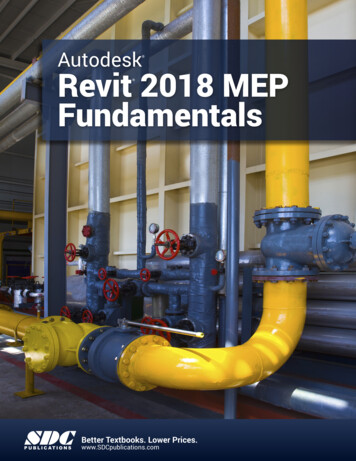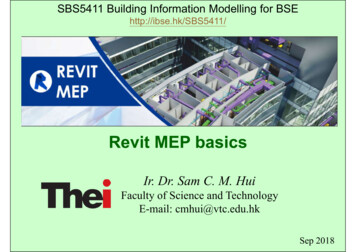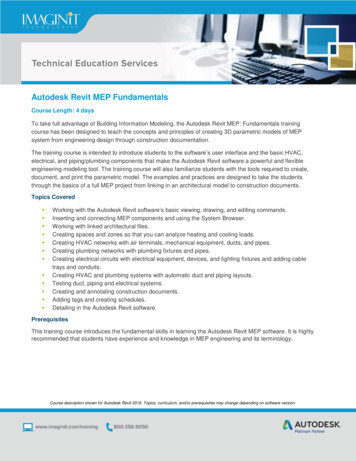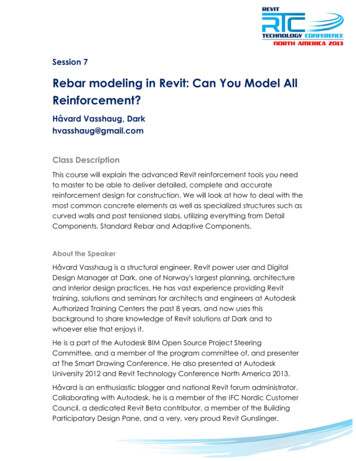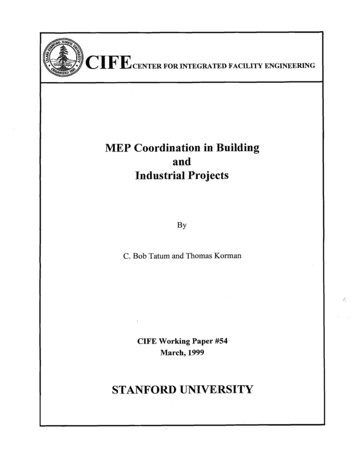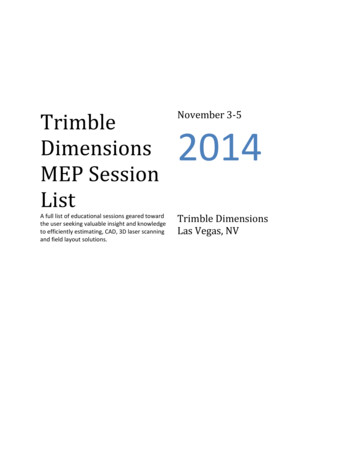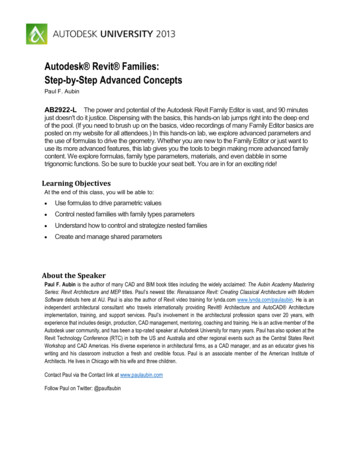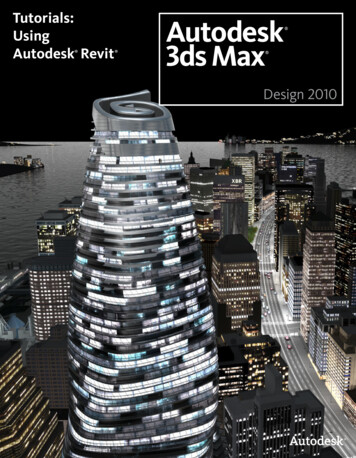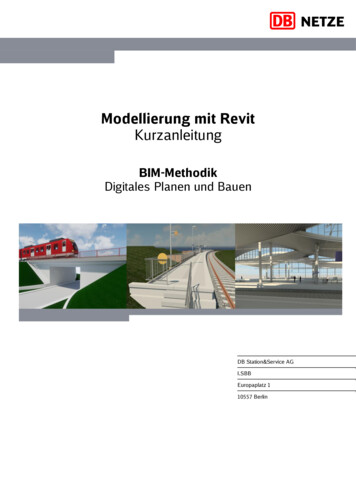
Transcription
Revit MEP Programming: All Systems GoJeremy TammikPrincipal Developer Consultant 2012 Autodesk
About the PresenterJeremy TammikPrincipal Developer ConsultantDeveloper Technical ServicesEMEA, Autodesk SARLJeremy is a member of the AEC workgroup of the Autodesk Developer Network ADN team,providing developer support, training, conference presentations, and blogging on the Revit API.He joined Autodesk in 1988 as the technology evangelist responsible for European developersupport to lecture, consult, and support AutoCAD application developers in Europe, the U.S.,Australia, and Africa. He was a co-founder of ADGE, the AutoCAD Developer Group Europe, anda prolific author on AutoCAD application development. He left Autodesk in 1994 to work as anHVAC application developer, and then rejoined the company in 2005.Jeremy graduated in mathematics and physics in Germany, worked as a teacher and translator,then as a C programmer on early GUI and multitasking projects. He is fluent in six Europeanlanguages, vegetarian, has four kids, plays the flute, likes reading, travelling, theatreimprovisation, yoga, carpentry, loves mountains, oceans, sports, dancing, and especially climbing. 2012 Autodesk
Class SummaryOverview of the Revit MEP API MEP API enhancements in Revit 2013 Working programmatically with Revit MEP models Overview of available Revit MEP API samples Prerequisites: we assume prior knowledge of How to program in .NETThe basics of the generic Revit APIRevit MEP product usage 2012 Autodesk
Learning ObjectivesAt the end of this class, you will be able to:Understand and use the Revit MEP 2013 API enhancements Analyze, create, manage and modify electrical, HVAC and plumbingmodels, systems, and components programmatically Understand and reuse Revit SDK and ADN sample functionality 2012 Autodesk
AgendaIntroduction Analysis Hierarchical systems and connectors Electrical HVAC and plumbing The Revit MEP 2013 API Sample applications Learning more 2012 Autodesk
Introduction 2012 Autodesk
Acronyms ADNAECAPIBIMGUIHVACMEPRACRMERSTSDKUIAutodesk Developer NetworkArchitecture, Engineering, ConstructionApplication Programming InterfaceBuilding Information ModelGraphical User InterfaceHeating, Ventilation, and Air ConditioningMechanical, Electrical, and PlumbingRevit ArchitectureRevit MEPRevit StructureSoftware Development KitUser Interface 2012 Autodesk
MEP Application RequirementsMechanical, electrical and plumbing domains M is for HVAC, i.e. heating, ventilation and air conditioning Model analysis tools Physical, thermal, environmental etc.Building codes and regulationsGeometrical relationshipsMEP project informationGreen Building XML, gbXMLSpaces and zonesBIM component and data access Systems, components, properties and parametersCreation and modificationTraversal and analysis 2012 Autodesk
The Generic Revit APIBasic Revit API is generic All flavours use the same Revit API .NET assemblies Specific additional features exist for each flavour, e.g. Room-related functionality in Revit ArchitectureAccess to the analytical model in Revit StructureAccess to the MEP model in Revit MEPOnebox supports all in one boxRuntime discipline switching ProductType Architecture, Structure, MEP, Revit 2012 Autodesk
Revit MEP API Evolution Generic element and parameter access can always be usedRevit 2008 provided no MEP-specific APIRevit 2009 introduced MEP-specific API support Revit MEP 2010 – mechanical Conduit, cable tray, panel scheduleRevit MEP 2012 – mechanical MEP namespace, support for HVAC and piping systemsRevit MEP 2011 – electrical MEP model property, space and zone, electrical and mechanical equipment, lightingdevice and fixture, connector, electrical systemPipe settings and sizes, placeholder elements, insulation and liningRevit MEP 2013 – mechanical and analysis Routing preferences, analysis and calculation enhancements, new and updated APIs 2012 Autodesk
Analysis 2012 Autodesk
MEP Project Info and EnergyDataSettings EnergyDataSettings object represents gbXML project info Manage Project Settings Project Information Energy DataAccess via EnergyDataSettings.GetFromDocument methodDefine settings for gbXML export, heating and cooling load calculations,conceptual energy analysisFor project location use Document.ActiveProjectLocation Green Building XML export Document.Export(string folder,string name,GBXMLExportOptions ); 2012 Autodesk
Spaces and Zones Architectural rooms are unsuitable for MEP analysis Wrong height, often too large for analysed regionMEP uses space instead of room, and zone to manage spaces Rooms can be subdivided into exterior and interior subspaces AddSpaceAndZone SDK sample Programmatic creation and management of spaces and zonesFamilyInstance class has Room and Space propertiesFamilyInstance fi; // get a family instanceSpace space fi.Space; // query space containing itSpace space2 fi.get Space( phase ); // space in a specificphase 2012 Autodesk
Model Inspection UtilitiesDetermine component location, space adjacency analysis, etc. Volumes, rooms and spaces FamilyInstance.Space determines space containing family instance Room.IsPointInRoom determines if a point is in a room volume Space.IsPointInSpace determines if a point is in a space volume GetRoomAtPoint and GetSpaceAtPoint return room or space containing point Element filters by intersection, Boolean operations, etc. BoundingBoxIntersectsFilter, BoundingBoxIsInsideFilter, ementFilter, ElementIntersectsSolidFilterRay intersectionReferenceIntersector class, ex FindReferencesWithContextByDirection method Shoot a ray through the model, given a starting point and direction vector Return an array of references of intersected elements and faces AvoidObstruction, FindColumns, MeasureHeight, RayTraceBounce SDK samples 2012 Autodesk
Revit 2013 ReferenceIntersector ClassConstructor specifies target elements, target type and 3D view Elements specified by ElementId, ElementIdSet , ElementFilter Target type can be elements, meshes, edges, curves, faces ReferenceIntersector( elements , FindReferenceTarget, View3d )Call Find or FindNearest to cast a ray given origin and direction Returns references intersecting ray, or closest to origin Find( XYZ origin, XYZ direction )FindNearest( XYZ origin, XYZ direction ) 2012 Autodesk
Conceptual Energy Analysis APIEnergy analysis on conceptual design models New overload of Document.Export method takingMassGBXMLExportOptions argument Create a gbXML file containing energy analysis elements generatedfrom conceptual mass family instances 2012 Autodesk
Detailed Energy Analysis Model API Produce analytical thermal model from physical building modelRetrieve energy analysis detail model and present as tree viewAccess Export to gbXML, Heating and Cooling Loads dataAnalytical thermal modelComposed of volumetric elements: spaces, zones, planar surfaces Created and initialised by calling EnergyAnalysisDetailModel.Create() Methods GetAnalyticalSpaces, Surfaces, Openings, ShadingSurfaces SDK sample Analysis EnergyAnalysisModel 2012 Autodesk
Hierarchical Systems and Connectors 2012 Autodesk
Hierarchical System Structure and MEP ModelMEP systems consist of hierarchically connected components Many components are represented using family instances Connectors can link neighbouring components and transfer info Top level node is MEP system Represented by MEPSystem class, with derived classes ElectricalSystem,MechanicalSystem, PipingSystemFamily instance provides MEPModel property MEPModel has ConnectorManager and ElectricalSystems propertiesDerived classes include ElectricalEquipment, LightingDevice, LightingFixture,MechanicalEquipment, MechanicalFitting 2012 Autodesk
Connectors Family editor connection elementsIndependent elements for defining connectors Used to model library parts in family context Specialised derived classes for duct, pipe and electrical connectors Connector classUsed to represent connections in the Revit BIM project context Part of MEP component, not independent Revit database element Logical connectorsUsed in electrical domain Cables and wires are possibly not specified Enables traversal of connectedelectrical system hierarchies Physical connectorsConnect neighbouring components physically Transmit sizing dimensions and flow information 2012 Autodesk
Electrical 2012 Autodesk
Electrical System HierarchyThree-tier recursive hierarchy, cf. electrical system browser Panel systems or circuits circuit elements, may be panels Logical connections between components Wires are annotation elements System can be traversed through connectors Connectivity information also available in element parameters Electrical samples PowerCircuit SDK sample shows creation and editing power circuitsPanelSchedule SDK demonstrates use of the electrical panel schedule APIAdnRme electrical sample demonstrates traversal using both MEP connectorsand generic parameters (much harder) 2012 Autodesk
HVAC and Plumbing 2012 Autodesk
HVAC and Piping HierarchySystems manage the top level system properties Ducts and pipes define the main flow elements Fittings implement bends and branches in the system Connectors hook up the ducts, pipes and fittings 2012 Autodesk
SystemsMechanicalSystem and PipingSystem classes Access to equipment, connectors and system type Access to system properties such as flow and static pressure DuctNetwork and PipeNetwork properties access system contents Ducts and fitting elements in no particular orderDoes not include terminals or equipmentsQuery connector managers for traversal in flow direction TraverseSystem SDK sample 2012 Autodesk
Duct and Pipes Represented by Duct, FlexDuct, Pipe and FlexPipe classes Derived from MEPCurveProvide read access to duct properties, types, and geometry Change duct or pipe type Move duct or pipe Use Move method rather than LocationLayout duct or pipe Driven by two points, point and connector, or two connectors 2012 Autodesk
FittingsRepresented by standard RFA family instances Created using dedicated creation doc New*Fitting methods Elbow, Tee, Cross, Takeoff, Transition, and Union Access fitting properties, shape and dimensions through theFamilyInstance.MEPModel property 2012 Autodesk
Connectors Read duct, pipe, and fitting connector properties Flow, Coefficient, DemandAccess physical connector properties Origin, Angle, Height, Width, RadiusRead and write assigned connector properties The fitting connectors define the properties Flow, Flow Configuration, Coefficients, Loss MethodChange connector size and location Connect and disconnect 2012 Autodesk
Element CreationMethods on Autodesk.Revit.Creation.Document Create New Systems Create New Elements NewMechanicalSystem, NewPipingSystemNewDuct, NewFlexDuct, NewPipe, NewFlexPipeCreate New Fittings New.Fitting for Cross, Elbow, TakeOff, TeeFitting, Transition, UnionNew classes Conduit, CableTray provide static Create methods Connector elements Created in the family context using methods on FamilyItemFactoryAccessed through the Document.FamilyCreate propertyNewDuctConnector, NewPipeConnector, NewElectricalConnector 2012 Autodesk
The Revit MEP 2013 APIand the past few releases as well. 2012 Autodesk
Revit MEP 2011 API Enhancements New classes for cable tray and conduit Panel schedules Pipe to conduit converter sampleAPI access and PanelSchedule SDK sampleOther Enhancements EnergyDataSettingsValidation in ElectricalSystem PropertiesWireMaterialType, InsulationType, TemperatureRatingTypeDuctConnector, PipeConnector, ElectricalConnectorDemand Factor and Load Classifications 2012 Autodesk
Revit MEP 2012 API EnhancementsPipe settings and sizes Placeholder ducts and pipes Duct and pipe insulation and lining Small Enhancements and Changes MEP related APIs Detailed Energy AnalysisConceptual Energy Analysis 2012 Autodesk
Revit MEP 2013 Product FeaturesRouting preferences Calculation enhancements MEP centrelines New MEP properties Enhanced analysis and simulation functionality 2012 Autodesk
MEP 2013 API EnhancementsRouting preferences MEP pressure loss calculation sections Fluid viscosity and density friction properties Thermal properties External services And more. 2012 Autodesk
Routing Preferences API Access Select preferred fitting types for various sizes and materials RoutingPreferenceManager class Manages routing preference rules for segments and fittingsQuery fitting or segment chosen by Revit for a given size conditionMEPCurveType RoutingPreferenceManager property Set routing preference policies for end usersQuery fittings and segments used for given size criteriaAccess main routing preferences object for a given MEPCurve typeCurrently only PipeType and DuctType support routing preferencesUse demonstrated by RoutingPreferenceTools SDK sample 2012 Autodesk
Routing Preference Helper Classes RoutingCriterionBase and PrimarySizeCriterion RoutingPreferenceRule Manage one segment or fitting preferenceRoutingCondition and RoutingConditions Criteria for fitting and segment selection based on min max size constraintsRoutingPreferenceManager.GetMEPPartId input to select fittings and segmentsSegment and PipeSegmentRepresent a length of MEPCurve of specific material and set available sizes Subclass representing a length of pipe RoutingPreferenceRuleGroupType enumerationTypes of routing items managed by routing preference rules Elbows, Junctions, Crosses, Transitions, Unions, MechanicalJoints, Segments,TransitionsRectangularToRound, TransitionsRectangularToOval, TransitionsOvalToRound 2012 Autodesk
Routing Preference UsageRouting preferences choose first symbol in rul
Revit MEP Programming: All Systems Go Jeremy Tammik Principal Developer Consultant. About the Presenter Jeremy Tammik Principal Developer Consultant Developer Technical Services EMEA, Autodesk SARL Jeremy is a member of the AEC workgroup of the Autodesk Developer Network ADN team, providing developer support, training, conference presentations, and blogging on the Revit API.
